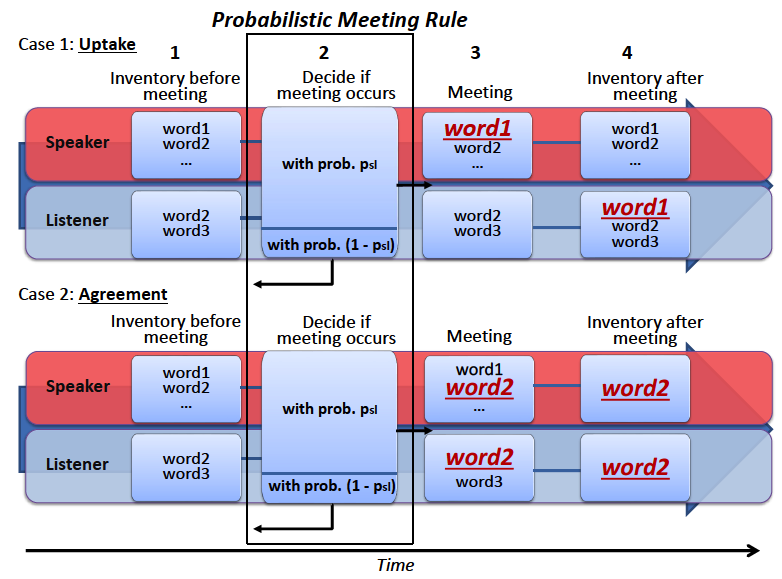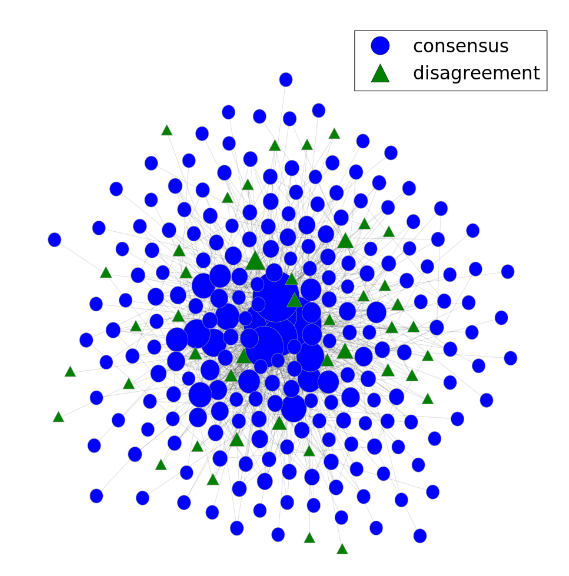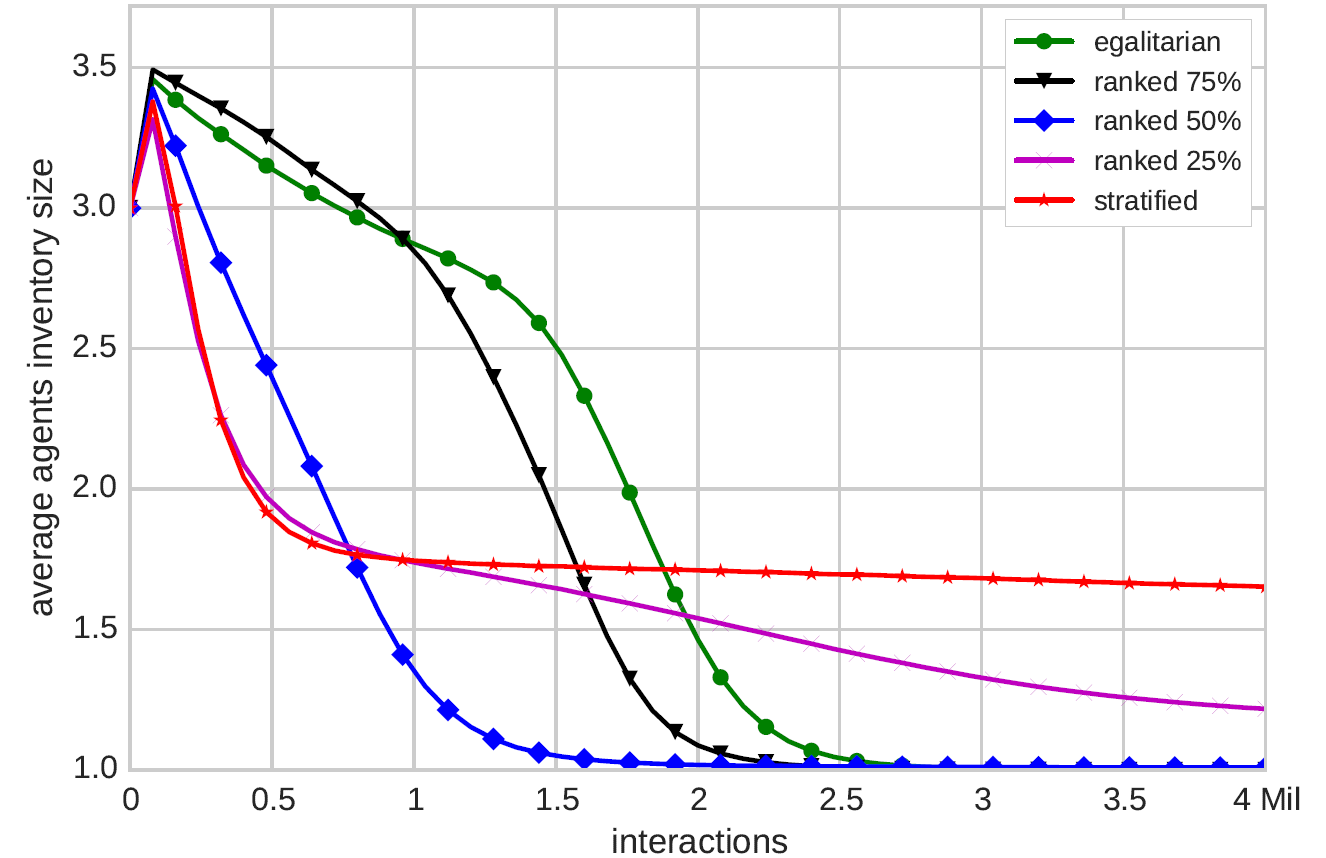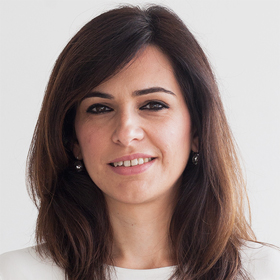Services for Engineering Consensus Building
Purpose
Services for engineering consensus building facilitate learners on negotiation processes taking place in terms of scaffolding in networked online environments. Typically, learners turn to networked online environments with the aim to seek for online help [1]. In this context, negotiation processes include learners’ interactions while understanding and defining certain problems, exchanging opinions, identifying the experts in the field, analysing possible solutions and building a consensus on a best provided solution. Our focus here is to address the scaffolding phenomenon in online settings by studying the role of learners’ social status on negotiation processes. With services for engineering consensus building we model the optimal extent of the influence of learners’ social status that speeds up the process of consensus building in collaboration networks.
Summed up, we provide the following main contributions:
- We introduce the Probabilistic Meeting Rule to configure the degree of the influence of social status on the negotiation processes in networked online environments [2] [3]
- We model the dynamics of opinion spreading by adapting a well known Naming Game model
- Through parametrization, we are able to explore various scenarios from the opposite sides of the spectrum: egalitarian, stratified and ranked societies
- Extending our model with also incorporating the structural similarities between learners [4]
Description
In online scaffolding settings, we define problems and try to solve them with the help of the online community [1]. The best solutions are usually found while interacting with many individuals that we do not know personally. It is difficult to identify the social status or the working experience of the individuals with whom we interact, if these are not made explicit by the system. This hinders users seeking for help to trust the online community because they can not relate the quality of the provided answers or solutions to the level of expertise or social status of individuals that proposed those solutions. The role of users’ social status on negotiation processes taking place in a networked learning environment was not tackled by state of the art research. Within the scope of the Layers project, we studied this problem by investigated the influence of learners’ social status on important decisions that learners have to make while collaborating online with their peers and provided services for engineering consensus building. An example of such online collaboration would be the largest Estonian online forum for construction professionals studied in [1]. Results of this study showed that the identification of the more authoritative opinions about a problem solution is the key issue.
First, we wanted to enhance the existing user recommenders in Layers, which are only tag-based recommenders, by providing more intelligent recommenders that additionally incorporate the social influence of the recommended users. This is also identified as a crucial problem by the work conducted in [1]. Second, we aimed to confirm the importance of the high social status users, known as hubs, on spreading a single common opinion to a large number of other users. Third, we wanted to find out if relying too much on the social status affects the quickness of the consensus building process.
Thus, we investigated the influence of social status on negotiation processes that take place in collaboration networks by means of agent-based simulations. To that end, we simulated the diffusion of opinions in empirical collaboration networks, derived from six language editions (French, Spanish, Chinese, Japanese, German and English) of the Q&A site StackEchange, by taking into account both the network structure and the individual differences of people, reflected through their social status. In our study, the social status was represented by social reputation, which was awarded by the community [2] [3]. Based on the policies of such sites users get appropriate reputation scores for giving good answers, asking good questions or for voting on questions/answers of other users.
We model the dynamics of opinion spreading by adapting a well known Naming Game model from the field of statistical physics [5] that has been already successfully applied to model opinion diffusion and consensus building process. In the Naming Game model, agent-to-agent interactions take place based on predefined gaming rules. In particular, agents exchange their opinions and try to reach a consensus about the name of an unknown object. When all agents in the network agree on the name, the network is considered to have established a common opinion. According to the Naming Game rules, each agent has an inventory of words (names) that is initially empty. At each interaction step two random agents are chosen to communicate. One of them is declared as a speaker and the other one as a listener. The listener selects a word from her inventory and communicates it to the listener. If the listener’s inventory is empty, a new unique word is created and stored in the inventory. After communicating the word to the listener, two scenarios are possible:
- (i) the word is not in the listener’s inventory – the word is added to listener’s inventory,
- (ii) otherwise, both speaker and listener agree on that word and remove all other words from their inventories – they agree on the selected word.
We extend the Naming Game model by incorporating a mechanism to configure the degree of the influence of social status on the network dynamics. We termed this mechanism the Probabilistic Meeting Rule, which is visualized in Figure 1. In this figure, the classical Naming Game consists of steps 1, 3 and 4. In step 2, we additionally decide whether the meeting between two agents occurs by evaluating the Probabilistic Meeting Rule, which is given by psl = min(1, eβ*(ss -sl)). Here, ss is the social status of the speaker and sl is the social status of the listener. The stratification factor β, which can be viewed as a measure of conformance to the agent’s social status, is a tuning parameter in our model.

Through parametrization, we are able to explore various scenarios from the opposite sides of the spectrum:
-
(i) we can completely neglect the status by allowing any two individuals to exchange their opinions regardless of their social status (an egalitarian society)
-
(ii) we can have opinions flowing only in one direction – from individuals with a higher social status to those with a lower social status (a stratified society)
-
(iii) we can probabilistically model any situation in between these two extreme cases, i.e., a case in which opinions are very likely to flow from individuals with a higher social status to those with a lower social status but with small probability they can also flow into the other direction (a ranked society).
Use Cases and Tool Support
One potential use case of our consensus engineering service is to support persons in finding consensus in their learning communities represented in the Social Semantic Server (SSS). One example of such a process is visualized in Figure 2, where the blue nodes reached consensus (have a single common opinion), whereas green nodes nodes did not adopt a common opinion. Thus, the goal of our service would be to transfer the green nodes into blue ones or if this is not possible, at least to speed up the process until the maximum level of consensus building is reached.

Identifying the most influential learners and recommending them to other learners could enhance the collaboration process in tools like KnowBrain and Bits and Pieces. The most influential learners or learners with a high social status contribute with high quality content when collaborating with their peers. They are also characterized with a high convincing power, so they can influence the opinions of others and speed up the process of consensus building.
Another potential use case would be to integrate this service into the user recommendations provided in Living Documents. Thus, users could be connected with other users based on the social status or level of expertise, which affects the professional knowledge accumulated in the community as a whole [1].
Research Results and Impact
Our research in terms of the Layers project has shown that the presence of high social status learners, known as hubs, in a networked online environment is crucial for negotiation processes, because such learners can distribute a single common opinion to a large number of other learners. Additionally, the consensus building process is indeed affected by the learners’ social status. But, there is a specific setting for each collaboration network, in which social status speeds up the consensus building process.
Figure 3 shows an example of these results for the English Stackexchange dataset [2] [3]. This figure shows the mean values of the user’s inventory size in relation to the number of interactions. In an egalitarian society (green line with circle markers), in which status does not play a role at all, a common opinion is reached and the convergence rate is fast (after 2.6 Mil user interactions). In a stratified society (red line with star markers), the opinions do not converge (mean number of opinions lies between 1.5 and 2). The highest convergence rate is evident in the ranked societies (e.g., blue line with diamond markers), a common opinion is reached after 1.8 Mil user interactions. . These results show that the consensus building depends on the status but in a non-obvious way, indicating that there is a specific setting at which the influence of the social status reaches the optimal state.

We have analysed in detail the opinion flow between classes of users, defined based on their social status. So, we have high social status users, having a social status above the 90th percentile, and low status agents - below 90th percentile. Figure 4 represents the percentage of the successful user interactions or meetings across the society classes. Based on the results in Figure 3, the quickest consensus is achieved in ranked society that are represented as blue bars with the line texture in Figure 4. More specifically, the quickest consensus is achieved when (i) low status collaborators are allowed to freely exchange opinions between themselves (since this reduces the need for high status collaborators to interact with low status ones) and (ii) simultaneously there exists a communication barrier reducing the number of interactions of low status collaborators towards high status ones (since this reduces the variance in opinions of high status collaborators). This corresponds to the blue bars with the line texture in Figure 4.
In the stratified society (red bars with star texture), a common opinion cannot be reached because the meeting rule is so strict that even communications between low users (low-to-low pairs) are severely impaired. In the egalitarian society (green bars with circle texture), the convergence is slower because low-status users disturb high-status users by inflicting their opinion upon them (low-to-high pairs).

In the last year of the project, we further investigated the role of the network structure and the correlation between social status and degree distribution. We found out that if degree and social status are not correlated, consensus is reached quickly and without external interventions. In collaboration networks in which degree strongly correlates with status, this correlation slows down the consensus reaching, making it necessary to take actions such as applying the Probabilistic Meeting Rule to insert a social barrier between low and high status agents.
In one of our latest research [4], we studied the role of learners similarity in correlation with learners social status on consensus building in online collaboration networks. Our results showed that when learners are guided to each other by their similarity the process of consensus building is slowed down. An increase in the influence of the learner social status speeds up this process. Thus, an optimal configuration for a faster consensus requires a careful balance between those two factors.
Summed up, we believe that by identifying most influential learners and their corresponding authoritative opinions (answers), and by involving them to collaborate with others, learners can reach consensus more quickly while trying to agree on a best provided solution to a particular problem.
Material
Links
-
Consensus Engineering framework: Link
-
Web site describing our research Link
-
Impact section describing how consensus building can be engineered in collaboration networks: Link
-
Slides presented at ASONAM’2015 in Paris, France:
Developers and Collaborators
Ilire Hasani-Mavriqi, Dominik Kowald, Tobias Ley, Elisabeth Lex
References
- K. Tammets, M. Laanpere, T. Ley, and K. Pata, “Identifying Problem-Based Scaffolding Patterns in an Online Forum for Construction Professionals,” in Scaling up Learning for Sustained Impact: 8th European Conference, on Technology Enhanced Learning, EC-TEL 2013, Paphos, Cyprus, September 17-21, 2013. Proceedings, D. Hernández-Leo, T. Ley, R. Klamma, and A. Harrer, Eds. Berlin, Heidelberg: Springer Berlin Heidelberg, 2013, pp. 526–531. DOI: 10.1007/978-3-642-40814-4_50
- I. Hasani-Mavriqi, F. Geigl, S. C. Pujari, E. Lex, and D. Helic, “The Influence of Social Status on Consensus Building in Collaboration Networks,” in Proceedings of the 2015 IEEE/ACM International Conference on Advances in Social Networks Analysis and Mining 2015, 2015, pp. 162–169.
- I. Hasani-Mavriqi, F. Geigl, S. C. Pujari, E. Lex, and D. Helic, “The influence of social status and network structure on consensus building in collaboration networks,” Social Network Analysis and Mining, vol. 6, no. 1, p. 80, 2016.
- I. Hasani-Mavriqi, D. Kowald, D. Helic, and E. Lex, “Consensus dynamics in online collaboration systems,” Computational Social Networks, vol. 5, no. 1, p. 24, Feb. 2018 [Online]. Available at: https://doi.org/10.1186/s40649-018-0050-1 DOI: 10.1186/s40649-018-0050-1
- A. Baronchelli, M. Felici, V. Loreto, E. Caglioti, and L. Steels, “Sharp transition towards shared vocabularies in multi-agent systems,” Journal of Statistical Mechanics: Theory and Experiment, vol. 2006, no. 06, p. P06014, 2006.
